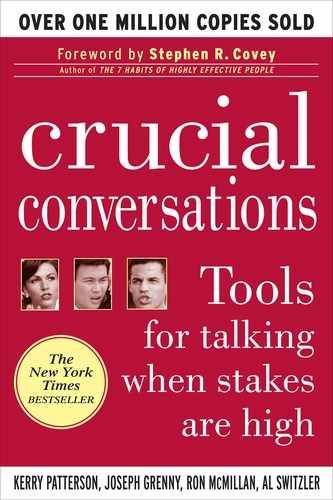Index
Action, moving to:
decisions leading to, 161–178, 185, 188, 192
lack of initiative, 204–205
(See also Path to Action)
Agreements:
failure to keep, 197–198
resolving differences, 82–88, 156–158, 188
Allen, Woody, 27
Apologies:
contrasting, 79
exploring others’ paths, 155
regrettable statements, 210
Archimedes, 17
Arguments, 12–13, 65, 156–158, 188
Asking others’ opinions, 131, 141–159, 185, 187, 190
Assignments, follow up, 176–178, 185, 188, 192, 204–205
Audio dialogue learning tools, 227
Authority:
decision making, 163–164
overly deferential persons, 198–200
Avoidance behavior:
dialogue model, 182–185
difficult situation, 201–202
silence strategy, 2–3, 37, 52, 61
Behavior:
aggressive, 50–51
avoidance, 2–3, 37, 52, 61, 201–202
dialogue model, 182–185
harassment, 194–195
insubordination, 208–209
mirroring, 149–150
motives, denoting, 42
overly sensitive persons, 196
patterns, 204–206, 207–208, 211–212
self-defeating strategies, 6–7
self-monitoring, 55–63
Blame, 29
Body language:
mirroring, 149–150
Mutual Respect, 71–72
Building on agreement, 157–158, 188
Butler, Samuel, 23
Career improvement, 9–10
Carnegie, Dale, 221
Choices:
clarifying, 40–43
command decisions, 168–169
consensus decisions, 171–173
distasteful, 37–41, 108–109, 114–115, 120–121, 122
important, 27
voting decisions, 170–171
Churchill, Winston, 215
City Slickers (film), 20
Command decisions, 165, 168–169, 178
Commitment:
decision making, 167
public, 224
Communities, 13–14
Comparisons in disagreements, 158, 188
Conditions of conversations, 45–63
Consultation, 165–166, 169–170, 178
Content of conversations:
overly sensitive persons, 196
Context of conversations, 79–80
Contrasting for misinterpretation:
overly sensitive persons, 196
personal observations, 211
safety, 76–82, 88, 89, 92, 130–131
Controlling behavior, 53, 61, 182–185
Conversations (See specific topics)
Cooperation, 167
Crime, 14
Cues for dialogue skills, 226
Decisions:
acting upon, 174–178, 185, 188
Defensiveness, 196
Devil’s advocate, playing, 135, 199–200
Dialogue skills:
about, 20–26
consultation decisions, 169–170
improving one’s own, 27–43
lack of, 213–214
learning tools, 179–192, 215–228
Difficult situations, 193–214
Disagreements, resolving, 82–88, 156–158, 188
Diseases, life-threatening, 15–16
Documenting work, 177, 178, 188, 192
Emotions:
crucial conversations, 2, 4, 48–49
learning dialogue skills, 217, 220
mastering, 93–118
Mutual Respect, 71–72
safety problems, 49–51
strong beliefs, 136–140
Expectations:
failing to keep agreements, 198
lack of initiative, 204–205
putting decisions into action, 175–176, 178
Facts:
interpretations, 105, 117, 203
resolving differences, 156–158
retracing Path to Action, 102
useful stories, 112–115
Fear (See Safety)
Follow up to assignments, 176–178, 185, 188, 192, 204–205
Fuller, Thomas, 193
Glaser, Ronald, 15
Goals:
determining, 27–43, 184, 186, 189
learning dialogue skills, 223–226
Groundhog Day (film), 205
Harassment, 194–195
Health, personal, 15–16
Helpless Stories, 108–109, 114–115, 118
Honesty:
motives, 30–33
observations, 210–211
(See also Sucker’s Choices)
How to Win Friends and Influence People (Carnegie), 221
Humanization of others, 113–114
Immune systems, 15–16
Improvement of dialogue skills and conversation, 27–43
clarifying choices in, 27, 40–43
motivation for, 30–43
Influence, personal, 17–20
Information:
free flow, 20–23
resolving differences, 157–158
Initiative, lack of, 203–205
Insubordination, 208–209
Intent, 68–70, 76–82, 108, 211
Internet for learning tools, 227–228
Jerry Springer Show (television program), 14
Johnson, Samuel, 161
Kellogg, Marjorie, 65
Kiecolt-Glaser, Janice, 15
Labeling, 53–54, 61, 108, 182–185
Learning dialogue skills, 179–192, 215–228
Lewin, Kurt, 224
Listening skills, 141–159
Markman, Howard, 12–13
Maslow, Abraham, 171–172
Mirroring, 149–150, 155, 159, 185, 187, 190
Models of dialogue skills, 182–185
Motives:
learning dialogue skills, 220, 223–226
own, 30–37
Murray, Bill, 205
Mutual Purpose:
avoidance behavior, 202
dialogue learning tools, 187, 189
difficult personal situations, 211
harassment, 195
lack of dialogue skills, 214
Mutual Respect:
dialogue learning tools, 187
Notarius, Clifford, 12–13
Objects, using to learn dialogue skills, 225–226
Online for learning tools, 227–228
Opinions:
others’, 131, 141–159, 185, 187, 190
strong beliefs, 136–140
(See also Talking tentatively)
Options (See Choices)
Organizational success, 10–12
Ouida, 45
Paraphrasing, 150–151, 155, 159, 185, 187, 190
Parker, Dorothy, 119
Parkinson, C. Northcote, 1
Path to Action:
about, 98–99
difficult situations, 123–135, 140, 203
harassment, 195
retracing, 102–112, 117, 184, 187, 190
Patterns of behavior, 204–206, 207–208, 211–212
Performance reviews, 224
Persuasion with facts, 126–127, 140
Physical reactions:
Pool of Shared Meaning:
about, 21–25
dialogue model, 182–185
listening to others, 141–159
risky information, 119–140
silence, 51
violence, 53
Powell, John, 179
Practicing dialogue skills, 222–223, 226, 228
Priming, 151–153, 155, 159, 185, 187, 190
Purpose:
different, 82–88
Mutual (See Mutual Purpose)
Quality, 11
Regrets, 209–210
Rehearsal of dialogue skills, 222
Relationships, 12–13, 68–74, 195–196
Respect:
harassment, 194–195
lack of, 208–209
Revenge, 37
Rusk, Dean, 141
Safety:
avoidance behavior, 201
learning dialogue skills, 180–192
listening to others, 142, 143, 148
organizational skills, 11
overly sensitive persons, 196
Pool of Shared Meaning, 21
priming, as listening tool, 151–153
restoring, 74–92
risky topics, 121–123, 130–131
watching for problems, 49–54
Scripts for dialogue skills, 217–220
Self-awareness:
interpreting observations, 93–118
overly deferential persons, 199
rarity of, 45
strong beliefs, 138–140
Style Under Stress, 56–62
Self-justification, 106–112
Sellouts, 109–112
Sensitivity to others, 195–196, 210–211
Sexual harassment, 194–195
Shakespeare, William, 99
Silence:
dialogue model, 182–185
overly sensitive persons, 195–196
strong beliefs, 137
watching for, 102, 117, 141–142, 180–181
Speaking skills, 119–140, 187, 149–150
Stories:
overly sensitive persons, 196
regrettable statements, 210
retracing Path to Action, 102, 117, 184, 187, 190
telling, 128–131, 140, 187, 190
Stress, Style Under, 56–62, 182–183
Sucker’s Choices:
difficult topics, 120–121, 122
Helpless Stories, 114–115
Surprises, 5, 193–194, 212–213, 216, 220
Talking tentatively:
avoidance behavior, 201
opinions, 131–135, 136, 140, 187
overly sensitive persons, 196
personal observations, 211
regrettable statements, 210
Time constraints:
decision making, 173–174
taking action, 176, 178, 188, 192
Time-outs, 207
Timing:
conversations becoming crucial, 48–49
insubordination, handling, 209
Tone of voice, 149–150
Tools:
audio dialogue learning tools, 227
for learning dialogue skills, 179–192, 215–228
priming, as listening tool, 151–153
video dialogue learning tools, 227
website for learning tools, 227–228
Topics of crucial conversations:
common, 7–8
difficult, 119–140
organizational, 11–12
Trust, failed, 200–201
Vague situations, 202–203
Victim Stories:
behavior patterns, 204, 205–206, 207–208
useful stories, 112–113
Video dialogue learning tools, 227
Villain Stories:
failed trust, 201
harassment, 194
Helpless Stories, 109
useful stories, 113–114
Violence:
dialogue model, 182–185
strong beliefs, 137
watching for, 102, 117, 180–181
Vocabulary (See Words)
Website for learning tools, 227–228
Withdrawal, 52–53, 61, 182 201–202
Words:
emotional, 103–104
judgmental, 105–106
mirroring, 149–150
word games, 211–212
